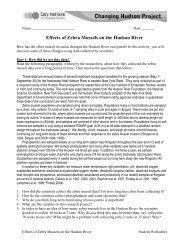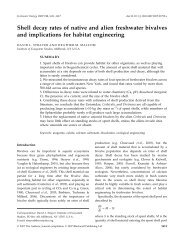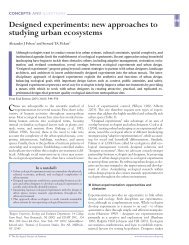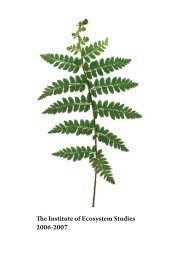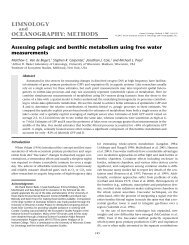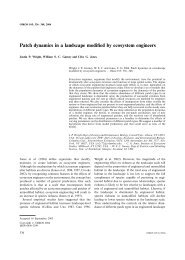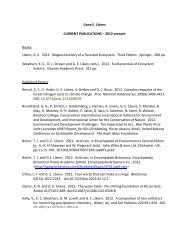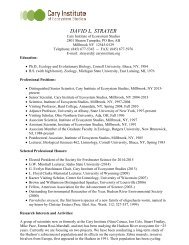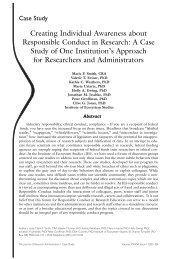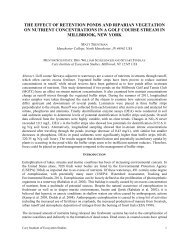Patterns and regulation of dissolved organic carbon
Patterns and regulation of dissolved organic carbon
Patterns and regulation of dissolved organic carbon
You also want an ePaper? Increase the reach of your titles
YUMPU automatically turns print PDFs into web optimized ePapers that Google loves.
1214 Sobek et al.<br />
Figure 4. Loadings plot <strong>of</strong> the partial least squares regression (PLS) analysis (total model<br />
R 2 Y 5 0.48). The graph depicts the correlation structures between the X variables <strong>and</strong> DOC<br />
concentration; variables situated along the same directional axis correlate positively with each<br />
other; variables situated at opposite ends <strong>of</strong> the plot correlate negatively with each other;<br />
variables situated in the center <strong>of</strong> the plot are poor predictors <strong>of</strong> DOC. The horizontal axis<br />
explains 38% <strong>of</strong> the variability in lake DOC, the vertical axis, 8%, <strong>and</strong> the third axis (explaining<br />
2%) was omitted for reasons <strong>of</strong> clarity. The square depicts the Y variable (DOC); circles depict<br />
continuous predictor variables; triangles depict l<strong>and</strong>-cover types. The following variables were<br />
log-transformed in order to approach normality: lake area, catchment area, drainage ratio,<br />
altitude, conductivity, soil C : N <strong>and</strong> DOC. The text labels for l<strong>and</strong>-cover types in the center <strong>of</strong> the<br />
plot were omitted for reasons <strong>of</strong> clarity.<br />
that the <strong>carbon</strong> budget <strong>of</strong> the studied l<strong>and</strong>scapes is not in<br />
steady state (i.e., increased run<strong>of</strong>f exports more DOC than<br />
is produced in soils, implying that observed increases are<br />
temporary), or that the changes in run<strong>of</strong>f are concomitant<br />
to changes in leachable <strong>organic</strong> <strong>carbon</strong> stocks in soils (i.e.,<br />
high run<strong>of</strong>f indicates a high water table, which favors DOC<br />
leaching <strong>and</strong> hampers microbial degradation due to anoxia<br />
<strong>and</strong> humification). Either way, the relationship between<br />
lake DOC <strong>and</strong> run<strong>of</strong>f presented in this study (Fig. 5A)<br />
represents the outcome <strong>of</strong> the interactions <strong>of</strong> many climatic<br />
<strong>and</strong> geographic factors over a long time (since the last<br />
deglaciation), while the observed changes in DOC export<br />
with changes in run<strong>of</strong>f (Andersson et al. 1991; Hinton et al.<br />
1997; Mulholl<strong>and</strong> 2003) span much shorter time periods<br />
(years to decades). Even though the DOC pool available in<br />
soils for mobilization <strong>and</strong> export by water is very large <strong>and</strong><br />
not easily depleted by fluxes <strong>of</strong> water (Mulholl<strong>and</strong> 2003),<br />
the negative relationship between run<strong>of</strong>f <strong>and</strong> lake DOC<br />
concentration indicates that when high run<strong>of</strong>f prevails over<br />
extended periods <strong>of</strong> time, the leachable soil <strong>organic</strong> <strong>carbon</strong><br />
pool will eventually be reduced.<br />
The relationship between soil properties <strong>and</strong> lake DOC—<br />
The positive relationship between lake DOC concentration<br />
<strong>and</strong> soil <strong>carbon</strong> density is in accordance with earlier studies<br />
that showed that the export <strong>of</strong> DOC from catchments is<br />
related to the <strong>organic</strong> <strong>carbon</strong> stocks in the catchment soils<br />
(Hope et al. 1994; Aitkenhead et al. 1999). Hence, we infer<br />
that allochthonous DOC is an important contributor to the<br />
DOC pool <strong>of</strong> lakes across a wide climatic gradient (Figs. 4,<br />
5). Since DOC has been recognized as a major modifier <strong>of</strong><br />
aquatic ecosystems (Wetzel 2001), these results demonstrate<br />
that the structure <strong>and</strong> functioning <strong>of</strong> lake ecosystems<br />
are tightly coupled to the terrestrial environment.<br />
The soil <strong>carbon</strong> data used in this analysis are a measure<br />
<strong>of</strong> the bulk soil <strong>carbon</strong> density in the 0–1-m soil pr<strong>of</strong>ile.<br />
Most <strong>of</strong> the DOC, however, originates from the uppermost<br />
<strong>organic</strong>-rich soil layers, <strong>and</strong> DOC concentrations in soil<br />
pore water decline sharply toward lower soil horizons<br />
(McDowell <strong>and</strong> Likens 1988). We therefore hypothesize<br />
that if we had been able to include a measure <strong>of</strong> <strong>organic</strong><br />
<strong>carbon</strong> content in the uppermost soil horizon in our<br />
analysis, this variable would have been a more powerful<br />
predictor <strong>of</strong> lake DOC than bulk soil <strong>carbon</strong> density.<br />
The C : N ratio <strong>of</strong> the soil explained a small (5%), but<br />
significant proportion <strong>of</strong> the variability in lake DOC<br />
(Figs. 4, 5E). It has been shown previously that the soil<br />
C : N ratio is a good predictor <strong>of</strong> the riverine export <strong>of</strong>



